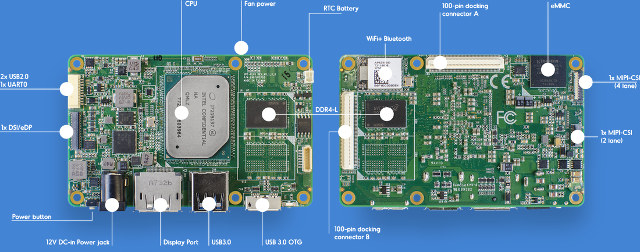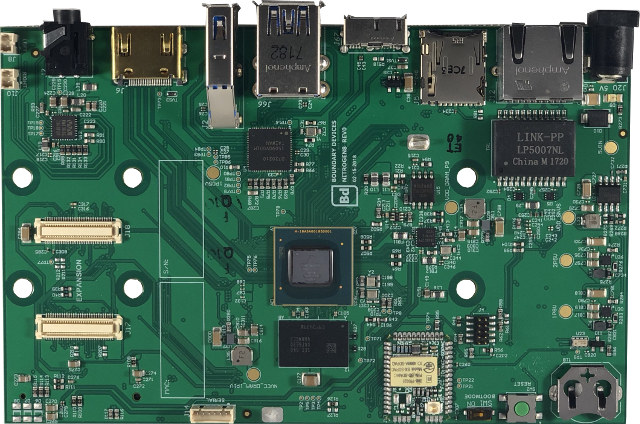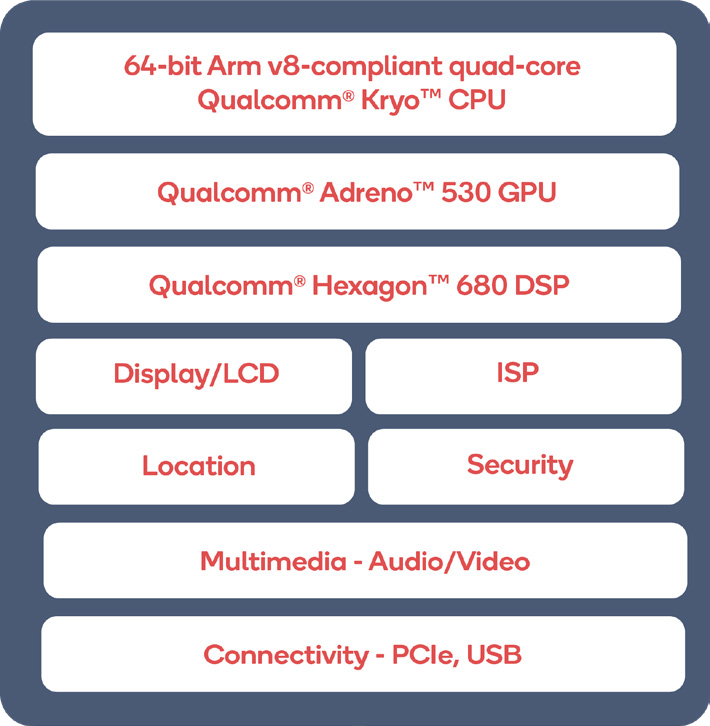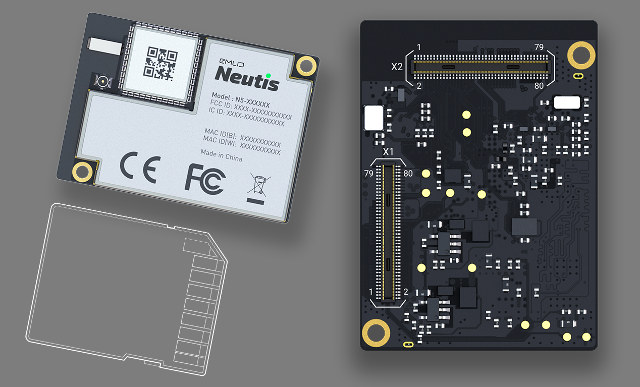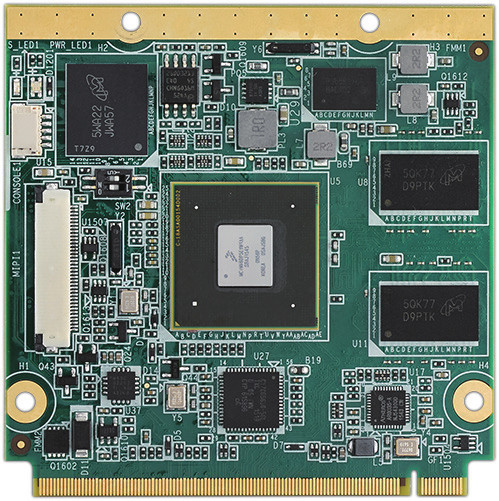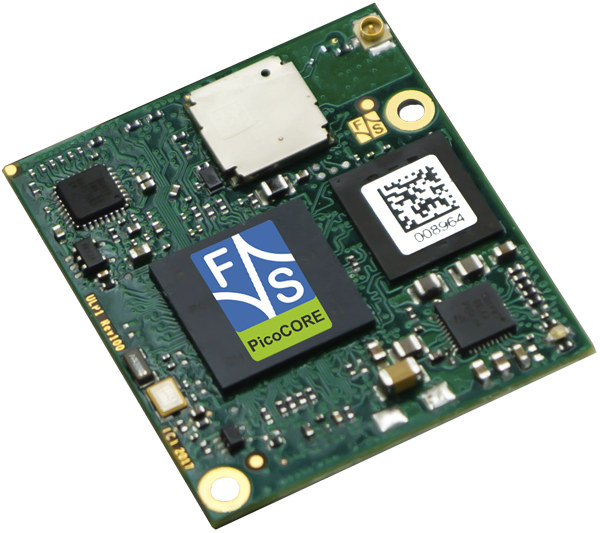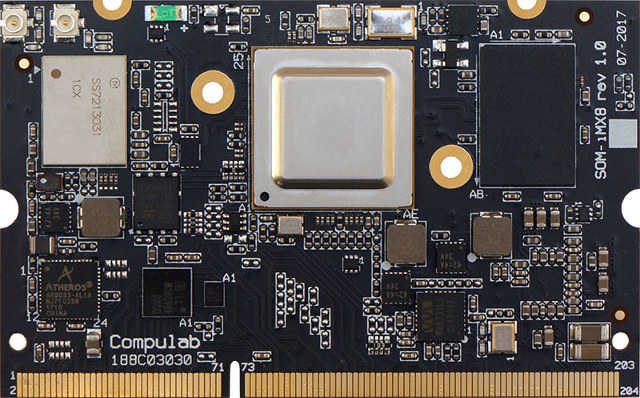We’ve just written about UP AI Core mPCIe card part of the new AI Edge family from UP Board, but other members will soon be released including UP Core Plus board, that builds upon UP Core Cherry Trail board launched last year, with a choice of Intel Atom x5/x7, and Celeron/Pentium Apollo Lake processors. The form factor is different, but just like the first UP Core board, the Core Plus board supports expansion boards via docking connectors such as the Net Plus Ethernet expansion, and the AI Plus expansion board with Intel Cyclone 10 GX FPGA. UP Core Plus specifications: SoC (one or the other) Intel Atom x5-E3940 (2M Cache, up to 2.00 GHz) Intel Atom x7-E3950 (2M Cache, up to 2.00 GHz) Intel Celeron N3350 (2M Cache, up to 2.50 GHz) Intel Pentium N4200 (2M Cache, up to 2.50 GHz) System Memory – 2GB, 4GB or 8GB on-board DDR4L-2400 […]
Nitrogen8M Single Board Computer with NXP i.MX 8MQuad Processor Comes with Up to 4GB RAM, 128 GB Storage
Boundary Devices Nitrogen6X was one of the first boards based on Freescale i.MX 6 processor when it launched in 2012, and even I never owned their board personally, I liked the fact the company published frequent updates about software development on their blog. With NXP i.MX 8 processors now officially available, the company introduced an update to their SBC with Nitrogen8X powered by NXP i.MX 8MQ quad-core processor, with 2 to 4 GB LPDDR4 RAM, 8 to 128 GB flash, a certified wireless module for WiFi and Bluetooth, and more. The form factor has changed dramatically, however. Nitrogen8M specifications: SoC – NXP i.MX 8MQuad ((Dual, QuadLite available on request) with four Cortex A53 core @ up to 1.5 GHz, one Cortex-M4F real-time core, and a Vivante GC7000Lite 2D/3D GPU System Memory – 2 or 4GB LPDDR4 (2GB standard) Storage – 16MB QSPI NOR Flash, 8GB eMMC flash (expandable to 128 […]
Qualcomm Snapdragon 820E Launched for the Embedded Market, DragonBoard 820c Board Selling for $199
Qualcomm Snapdragon processors are mainly used in smartphones manufactured in high volume, and in the past if you contacted the company to use their processor for your custom project with a target yearly production of a few thousands pieces, they’d just ignore you. This started to change in late 2016 with the launch of Snapdragon 410E and 600E processors based on mobile version of Snapdragon 410 and 600 processors minus the modem, but instead targeting the embedded space and the Internet of Things, which anybody could purchase easily through Arrow Electronics, and offering a 10-year life cycle. Those are good if you are satisfied with entry-level or mid-range processor, but the company has now announced the launch of Snapdragon 820E for customers requiring better performance for their application. Snapdragon 820E specifications appears to be moslty the same as Snapdragon 820 except for the lack of X12 cellular modem: CPU – 4x Qualcomm […]
Neutis N5 is a $49 Allwinner H5 SoM with WiFi and Bluetooth
Allwinner, Amlogic and Rockchip SoCs can be found in many single board computers or development boards, but contrary to processors from Texas Instruments, NXP or Atmel, there aren’t that many system-on-modules based on the low cost SoCs with companies like Pine64, Olimex, or Theobroma providing some options in that space. There soon will be more, as Emlid will launch Neutis N5 module based on Allwinner H5 processor in the next couple of months with the module also including WiFi and Bluetooth, beside the processor, memory, and storage. Neutis N5 specifications: SoC – Allwinner H5 quad core Arm Cortex-A53 processor with Arm Mali-450MP4 GPU System Memory – 512 MB DDR3 RAM Storage – 8 GB eMMC flash Connectivity – Wi-Fi: 802.11 b/g/n. BT: 4.0 dual-mode BLE with on-board antenna and U.FL connector for optional external antenna HW Security – Tamper-resistant dedicated crypto chip for storing cryptographic keys, unique ID, random number […]
Advantech ROM-7720 is a Qseven 2.1 Compliant i.MX 8 QuadMax Computer-on-Module
Many solutions based on NXP i.MX8 processors are likely to be announced during Embedded World 2018 next week. We’ve already seen several NXP i.MX 8M Cortex A53 based modules such as Variscite DART-MX8M or Compulab CL-SOM-IMX8 systems-on-module, and more are coming. One of those will be Advantech ROM-7720 computer-on-module (CoM) featuring the top of the line NXP i.MX 8 QuadMax Cortex A72/A53 processor and following QSeven 2.1 specifications / form factor. Advantech ROM-7720 CoM specifications: SoC – NXP i.MX 8QuadMax processor with 2x Cortex A72 cores @ up to 1.6GHz, 4x Cortex A53 cores, 2x Cortex-M4F real-time cores, a HiFi 4 DSP, and 2x Vivante GC7000XSVX GPUs System Memory – 2GB LPDDR4 @ 1600 MHz (optional 4GB RAM) Storage – 8 GB eMMC Flash for OS, 64 MB Quad SPI Flash for boot loader Video Output / Display I/F 2x 24-bit LVDS, 1366 x 768 for 1ch; 1920 x 1080 […]
Embedded Linux Conference & IoT Summit 2018 Schedule
The Embedded Linux Conference 2018 and the OpenIoT Summit 2018 will jointly take place next month, on March 12 – 14, 2018 in Portland, Oregon, USA. The former is a “vendor-neutral technical conference for companies and developers using Linux in embedded products”, while the latter is a “technical conference for the developers and architects working on industrial IoT”. The Linux Foundation has already published the schedule, and it’s always useful to learn what will be discussed about even for people who won’t attend. With that in mind, here’s my own virtual schedule with some of the talks I find interesting / relevant to this blog. Monday, March 12 10:50 – 11:40 – Progress in the Embedded GPU Ecosystem by Robert Foss, Collabora Ltd. Ten years ago no one would have expected the embedded GPU ecosystem in Linux to be what it is now. Today, a large number of GPUs have […]
PicoCORE MX7ULP is a Compact Module Based on NXP i.MX 7ULP Ultra Low Power Processor
NXP unveiled another variant of their i.MX 7 Cortex A7 processor last year, and I missed it. NXP i.MX 7ULP offers many of the same features as i.MX 7, but is manufactured using FD-SOI (Fully Depleted Silicon On Insulator) process technology to offer lower power consumption, as low as 15 mW or less in deep sleep, or 17 times less in comparison to i.MX 7 devices, while the dynamic power efficiency is improved by 50 percent on the real time domain (Cortex-M4). I found out about it thanks to an email from F&S Elektronik Systeme about the introduction of their PicoCORE MX7ULP module – based on i.MX 7ULP processor – at the Embedded World 2018 conference. PicoCORE MX7ULP CoM specifications: SoC – NXP i.MX 7ULP Arm Cortex-A7 processor @ up to 800 MHz, with Arm Cortex-M4 real-time core, and 2D/3D graphics accelerator System Memory – Up to 1GB LPDDR3 Storage […]
Compulab CL-SOM-iMX8 SoM Features NXP i.MX 8M Processor for $68 and Up
I just covered one of the i.MX 8M systems-on-module last Friday with Variscite DART-MX8M SoM, but Variscite is not the only company about to launch such modules, and today I’ll have a look at Compulab CL-SOM-iMX8 system-on-module based on the same NXP i.MX 8M dual or quad core Cortex A53 processor. Compulab’s SoM comes with up to 4GB RAM, 64GB eMMC flash, an optional WiFi & Bluetooth module, as well as optional support for Ethernet, LVDS, analog audio, and more. Contrary to most competitors, the company has also made an habit of releasing detailed pricing the basic configuration and per option. But first, let’s go through the specifications: SoC (one of the other) NXP i.MX8M Quad quad core Arm Cortex-A53 processor @ 1.5GHz with Arm Corex-M4 real-time core, Vivante GC7000Lite GPU supporting OpenGL ES 3.1, Open CL 1.2 and Vulkan NXP i.MX8M Dual dual core Arm Cortex-A53 processor @ 1.5GHz […]


